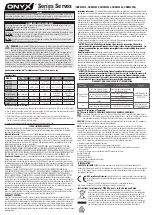
The SAB cannot regenerate energy back to the grid. It is
possible to connect and configure a brake resistor to the
SAB that can consume some power if the DC-link voltage
becomes too high (see
). If this
is unsuccessful, or if the load drives the servo drive, the
SAB shuts down and shows a fault when a critical DC bus
voltage level is reached.
The servo drive cannot regenerate energy back to the
input. Therefore, it limits the energy accepted from the
motor. If this is unsuccessful, or if the load drives the
motor, the servo drive shuts down and displays a fault
when a critical DC bus voltage level is reached.
4.1.5 Acoustic Noise
Acoustic noise from the servo drive comes from the
following sources:
•
Shaft seal
•
Ball bearings
•
Speed
•
Brake
4.1.6 Vibration and Shock
The VLT
®
Integrated Servo Drive ISD 510 is tested
according to a procedure based on IEC 60068-2-64.
The servo drive is intended for use on rotary parts/
machines.
4.2 Operating Environment: SAB
4.2.1 Humidity
Although the SAB can operate properly at high humidity,
avoid condensation. There is a specific risk of condensation
when the SAB is colder than moist ambient air. Moisture in
the air can also condense on the electronic components
and cause short circuits. Condensation occurs in units
without power. It is recommended to install a cabinet
heater when condensation is possible due to ambient
conditions. Avoid installation in areas subject to frost.
Alternatively, operating the SAB in standby mode (with the
unit connected to the mains) reduces the risk of conden-
sation. Ensure that the power dissipation is sufficient to
keep the SAB circuitry free of moisture.
4.2.2 Ambient Temperature
Minimum and maximum ambient temperature limits are
specified for the SAB (see
chapter 6.2.5 General Specifi-
cations and Environmental Considerations
). Avoiding
extreme ambient temperatures prolongs the life of the
equipment and maximizes the overall system reliability.
Follow the recommendations listed for maximum
performance and equipment longevity.
•
Although the SAB can operate at temperatures
down to 0
°
C, proper operation at rated load is
only guaranteed at
≥
5
°
C.
•
Do not exceed the maximum temperature limit.
•
The lifetime of electronic components decreases
by 50% for every 10
°
C operated above the
design temperature.
•
Additional air conditioning of the cabinet or
installation site may be required.
4.2.3 Cooling
The SAB dissipates power in the form of heat. Cooling
(heat dispersal) is primarily via the integrated fans. The
following recommendations are necessary for effective
cooling of the units.
•
Maximum air temperature to enter enclosure
must never exceed 50
°
C (122
°
F).
•
Day/night average temperature must not exceed
45
°
C (113
°
F).
•
Mount the unit to allow for free cooling airflow
through the cooling fins. See
for correct mounting
clearances.
•
Provide minimum front and rear clearance
requirements for cooling airflow. See the
VLT
®
Integrated Servo Drive ISD 510 System Operating
Instructions
for the installation requirements.
4.2.3.1 Cooling Fans
The SAB has built-in fans to ensure optimum cooling. The
main fan forces the airflow along the cooling fins on the
heat sink, ensuring cooling of the internal air. The SAB has
a small secondary fan on the power control board,
ensuring that the internal air is circulated to avoid hot
spots. The main fan is controlled by the internal
temperature in the SAB and the speed gradually increases
along with temperature. This reduces noise and energy
consumption when the need is low, and ensures maximum
cooling when needed.
In case of overtemperature inside the SAB, an alarm or
warning is issued and a coast and trip lock occurs.
System Integration
VLT
®
Integrated Servo Drive ISD
®
510 System
34
Danfoss A/S © 08/2017 All rights reserved.
MG36C102
4
4
















































